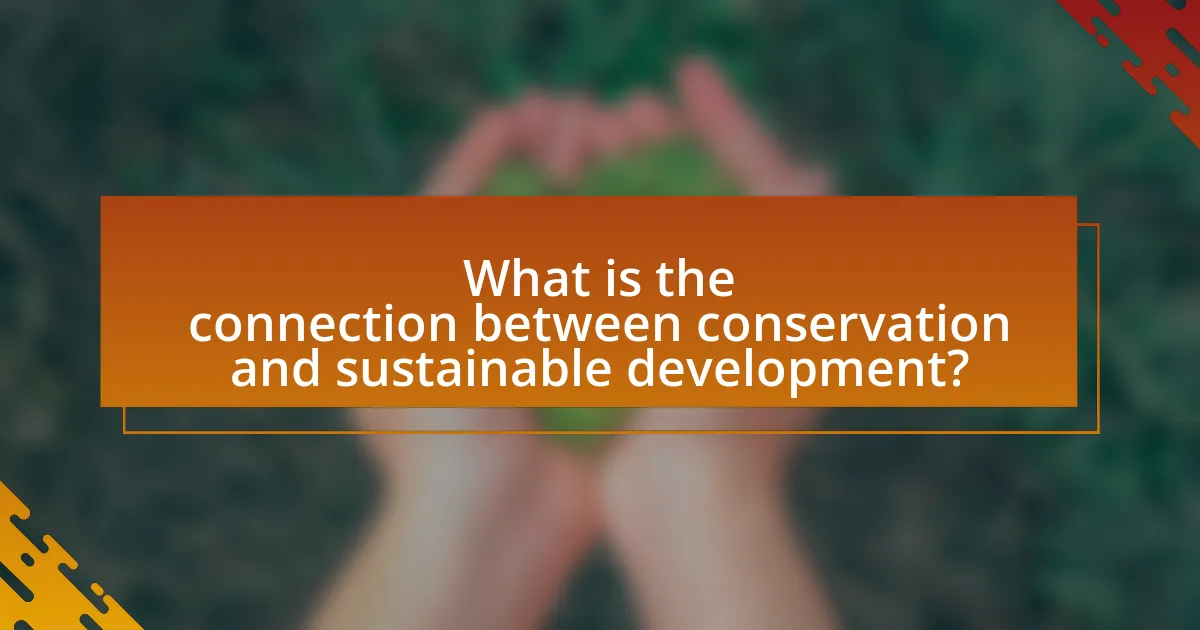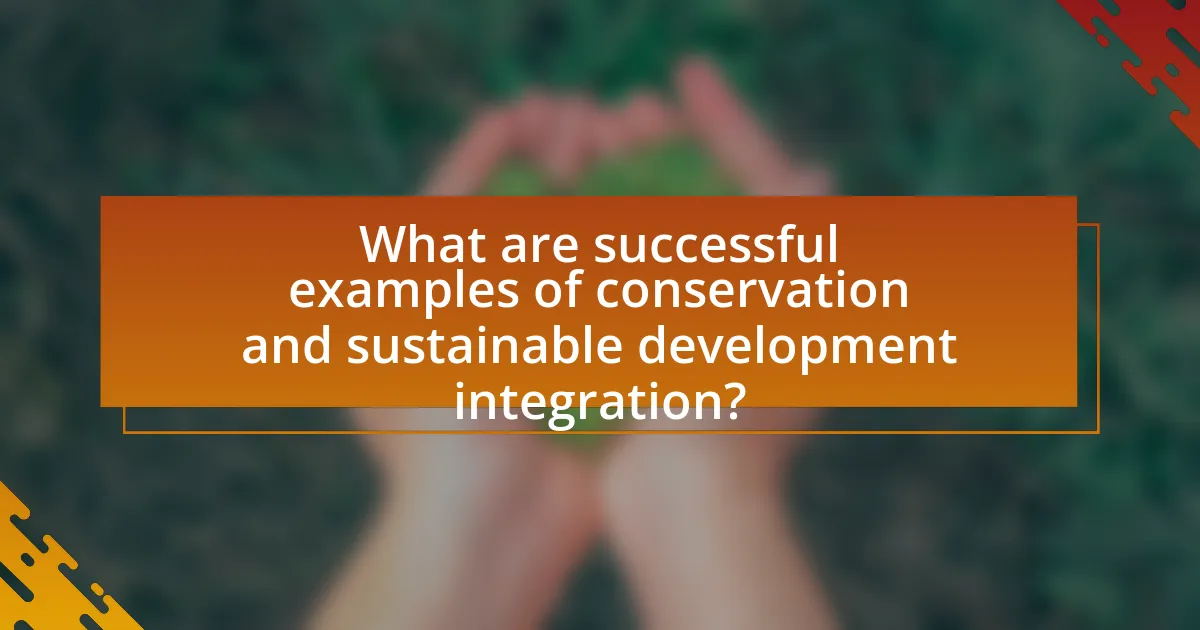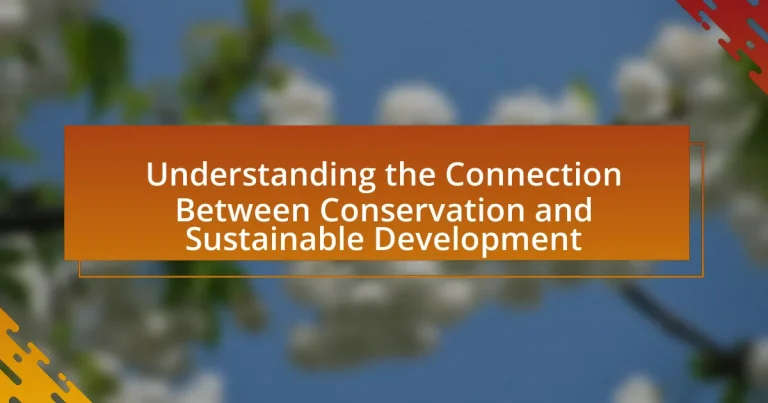The article explores the critical relationship between conservation and sustainable development, emphasizing their shared goal of protecting natural resources while enhancing human well-being. It outlines how conservation efforts support sustainable development goals by preserving biodiversity and ecosystem services essential for food security, clean water, and economic growth. Key principles such as sustainable resource use, community involvement, and ecosystem management are discussed, along with the economic benefits of biodiversity conservation. The article also addresses the challenges of integrating conservation with development, highlighting the importance of stakeholder collaboration and successful case studies that demonstrate effective strategies for achieving both environmental and economic objectives.

What is the connection between conservation and sustainable development?
Conservation and sustainable development are interconnected as both aim to protect natural resources while promoting human well-being. Conservation focuses on preserving biodiversity and ecosystems, which are essential for maintaining the ecological balance necessary for sustainable development. For instance, the United Nations’ Sustainable Development Goals emphasize the importance of conserving marine and terrestrial ecosystems to ensure food security and sustainable livelihoods. This relationship is evident in initiatives that integrate conservation practices into economic planning, demonstrating that safeguarding the environment can lead to long-term social and economic benefits.
How do conservation efforts support sustainable development goals?
Conservation efforts support sustainable development goals by preserving biodiversity, which is essential for ecosystem services that underpin human well-being. For instance, healthy ecosystems provide clean water, food security, and climate regulation, directly contributing to goals such as Zero Hunger (Goal 2) and Clean Water and Sanitation (Goal 6). Additionally, conservation initiatives can enhance economic growth through ecotourism, aligning with Decent Work and Economic Growth (Goal 8). Research indicates that protecting natural habitats can lead to a 30% increase in local economies reliant on sustainable practices, demonstrating the tangible benefits of conservation for sustainable development.
What are the key principles of conservation that align with sustainable development?
The key principles of conservation that align with sustainable development include the sustainable use of natural resources, biodiversity preservation, ecosystem management, and community involvement. Sustainable use of natural resources ensures that resources are utilized in a way that meets current needs without compromising future generations’ ability to meet their own needs. Biodiversity preservation is crucial as it maintains ecosystem resilience and functionality, which are essential for human survival and well-being. Ecosystem management focuses on maintaining the health of ecosystems to support both human activities and natural processes. Community involvement emphasizes the importance of engaging local populations in conservation efforts, recognizing their knowledge and dependence on natural resources, which fosters stewardship and sustainable practices. These principles are supported by the United Nations’ Sustainable Development Goals, which advocate for responsible consumption and production patterns, as well as the protection of ecosystems and biodiversity.
How does biodiversity conservation contribute to economic sustainability?
Biodiversity conservation contributes to economic sustainability by maintaining ecosystem services that are essential for human well-being and economic activities. Healthy ecosystems provide services such as pollination, water purification, and climate regulation, which directly support agriculture, fisheries, and tourism industries. For instance, the World Economic Forum estimates that over half of the global GDP is dependent on nature, highlighting the economic value of biodiversity. Furthermore, preserving biodiversity can lead to increased resilience against environmental changes, reducing costs associated with disaster recovery and resource scarcity. This interdependence between biodiversity and economic activities underscores the necessity of conservation efforts for sustainable economic growth.
Why is understanding this connection important?
Understanding the connection between conservation and sustainable development is important because it enables effective resource management and promotes ecological balance. This connection ensures that natural resources are utilized in a way that meets current needs without compromising the ability of future generations to meet theirs. For instance, the United Nations’ Sustainable Development Goals emphasize the necessity of protecting ecosystems while fostering economic growth, highlighting that sustainable practices can lead to improved livelihoods and environmental health. By recognizing this relationship, policymakers can create strategies that integrate environmental conservation into economic planning, ultimately leading to sustainable communities and biodiversity preservation.
What are the potential consequences of neglecting the link between conservation and sustainable development?
Neglecting the link between conservation and sustainable development can lead to significant environmental degradation and loss of biodiversity. When conservation efforts are not integrated with sustainable development practices, ecosystems can suffer from overexploitation, habitat destruction, and pollution, which ultimately threaten the survival of various species. For instance, the World Wildlife Fund reports that human activities have led to a decline of 68% in global wildlife populations since 1970, highlighting the urgent need for a cohesive approach. Additionally, neglecting this link can exacerbate social inequalities, as marginalized communities often rely on natural resources for their livelihoods. This disconnect can result in economic instability and increased poverty, as unsustainable practices deplete resources that communities depend on.
How can this understanding influence policy-making and community practices?
Understanding the connection between conservation and sustainable development can significantly influence policy-making and community practices by promoting integrated approaches that balance ecological health with economic growth. This understanding encourages policymakers to create regulations that protect natural resources while fostering sustainable livelihoods, as seen in initiatives like the United Nations Sustainable Development Goals, which emphasize the importance of environmental sustainability in achieving economic and social objectives. Additionally, community practices can be shaped by this understanding through the implementation of local conservation programs that engage residents in sustainable practices, thereby enhancing community resilience and ecological stewardship. For instance, community-led conservation efforts in places like Costa Rica have demonstrated that involving local populations in decision-making leads to better environmental outcomes and improved economic conditions.

What are the challenges in integrating conservation and sustainable development?
The challenges in integrating conservation and sustainable development include conflicting priorities, limited resources, and inadequate stakeholder engagement. Conflicting priorities arise when economic development goals clash with environmental protection efforts, leading to tensions between conservationists and developers. Limited resources, such as funding and manpower, hinder the implementation of effective conservation strategies alongside development projects. Inadequate stakeholder engagement often results in a lack of local support and participation, which is crucial for the success of both conservation and sustainable development initiatives. These challenges are documented in various studies, including the 2019 report by the United Nations Environment Programme, which highlights the necessity of aligning economic incentives with environmental sustainability to overcome these barriers.
What are the common conflicts between conservation efforts and development projects?
Common conflicts between conservation efforts and development projects include land use competition, resource allocation, and differing priorities regarding economic growth versus environmental protection. For instance, development projects often require land that is crucial for biodiversity, leading to habitat destruction and species loss. According to the World Wildlife Fund, approximately 60% of the world’s ecosystems are under threat due to urbanization and industrialization. Additionally, development initiatives may prioritize short-term economic benefits, such as job creation and infrastructure development, over long-term ecological sustainability, which can result in irreversible environmental damage. These conflicts highlight the tension between immediate human needs and the necessity of preserving natural ecosystems for future generations.
How do economic interests often clash with environmental protection?
Economic interests often clash with environmental protection when profit-driven activities, such as industrial development, resource extraction, and agriculture, lead to environmental degradation. For instance, the logging industry prioritizes timber production over forest conservation, resulting in deforestation, loss of biodiversity, and disruption of ecosystems. According to a study by the World Resources Institute, deforestation contributes to approximately 10% of global greenhouse gas emissions, highlighting the environmental cost of prioritizing economic gain over ecological health. This conflict is further exacerbated by policies that favor short-term economic benefits, often neglecting long-term sustainability and environmental stewardship.
What role does local community involvement play in these conflicts?
Local community involvement plays a crucial role in conflicts related to conservation and sustainable development by influencing decision-making processes and resource management. When local communities actively participate, they can advocate for their needs and priorities, which often leads to more equitable and effective conservation strategies. For instance, studies have shown that community-led initiatives in biodiversity conservation can result in a 30% increase in local species populations compared to top-down approaches. This evidence highlights that local engagement not only fosters a sense of ownership but also enhances the sustainability of conservation efforts, ultimately reducing conflicts between conservation goals and community livelihoods.
How can these challenges be addressed?
To address the challenges between conservation and sustainable development, integrated approaches that combine ecological preservation with economic growth must be implemented. These approaches include promoting sustainable land-use practices, enhancing community engagement in conservation efforts, and fostering partnerships between governments, NGOs, and local communities. For instance, the World Wildlife Fund’s “Living Planet Report” highlights that sustainable practices can lead to improved biodiversity outcomes while supporting local economies. Additionally, policies that incentivize conservation, such as payment for ecosystem services, have proven effective in various regions, demonstrating that economic benefits can align with environmental goals.
What strategies can be implemented to balance conservation and development needs?
To balance conservation and development needs, integrated land-use planning is essential. This strategy involves coordinating land use to ensure that ecological integrity is maintained while allowing for economic growth. For instance, the World Bank emphasizes that sustainable land management practices can enhance agricultural productivity while preserving biodiversity. Additionally, stakeholder engagement is crucial; involving local communities in decision-making fosters stewardship and aligns development projects with conservation goals. Research by the International Union for Conservation of Nature indicates that participatory approaches lead to more effective conservation outcomes. Furthermore, implementing economic incentives, such as payments for ecosystem services, can motivate landowners to prioritize conservation efforts alongside development. These strategies collectively create a framework where conservation and development can coexist harmoniously.
How can stakeholder collaboration enhance outcomes for both conservation and development?
Stakeholder collaboration enhances outcomes for both conservation and development by integrating diverse perspectives and resources, leading to more effective and sustainable solutions. When stakeholders, including governments, NGOs, local communities, and businesses, work together, they can align their goals, share knowledge, and pool financial and technical resources. This collaborative approach has been shown to improve project outcomes; for instance, a study by the World Resources Institute found that multi-stakeholder initiatives in conservation areas led to a 30% increase in biodiversity and improved livelihoods for local communities. By fostering communication and trust among stakeholders, collaboration also facilitates adaptive management practices that respond to changing environmental conditions, ensuring that both conservation efforts and development initiatives are resilient and mutually beneficial.

What are successful examples of conservation and sustainable development integration?
Successful examples of conservation and sustainable development integration include the Costa Rican Payment for Ecosystem Services (PES) program, which incentivizes landowners to conserve forests while promoting sustainable agricultural practices. This program has led to a significant increase in forest cover, from 21% in 1987 to over 52% in 2021, demonstrating a successful balance between economic development and environmental conservation. Another example is the Great Green Wall initiative in Africa, aimed at combating desertification and promoting sustainable land management across 11 countries. This initiative has restored over 15 million hectares of land, improving food security and livelihoods while enhancing biodiversity. These cases illustrate effective strategies that harmonize conservation efforts with sustainable development goals.
What case studies illustrate effective collaboration between conservation and development?
Case studies illustrating effective collaboration between conservation and development include the Amazon Region Protected Areas (ARPA) program in Brazil and the Integrated Conservation and Development Projects (ICDPs) in Madagascar. The ARPA program, initiated in 2002, aims to protect over 150 million hectares of rainforest while promoting sustainable livelihoods for local communities, demonstrating a successful balance between environmental protection and economic development. In Madagascar, ICDPs have integrated conservation efforts with community development initiatives, leading to improved biodiversity outcomes and enhanced local economies. These case studies provide concrete examples of how strategic partnerships can yield positive results for both conservation and development objectives.
How have specific regions benefited from integrated approaches?
Specific regions have benefited from integrated approaches by achieving enhanced biodiversity conservation and improved socio-economic outcomes. For instance, in the Amazon Basin, integrated land-use planning has led to a 30% reduction in deforestation rates while simultaneously increasing local community incomes through sustainable agriculture practices. This dual benefit demonstrates how integrated approaches can align environmental goals with economic development, fostering resilience and sustainability in the region.
What lessons can be learned from these successful examples?
Successful examples in conservation and sustainable development demonstrate the importance of integrating local communities into conservation efforts. Engaging local populations fosters stewardship and ensures that conservation initiatives align with their needs and values. For instance, the success of community-based conservation projects in Namibia, where local communities manage wildlife resources, has led to increased biodiversity and economic benefits through eco-tourism. This model shows that when communities are empowered, they actively participate in preserving their environment while benefiting economically. Additionally, these examples highlight the necessity of adaptive management practices that respond to changing environmental conditions and community feedback, ensuring long-term sustainability.
How can individuals contribute to this integration?
Individuals can contribute to the integration of conservation and sustainable development by adopting sustainable practices in their daily lives. For instance, reducing waste, conserving water, and supporting local and sustainable products directly impact environmental health and promote economic resilience. Research indicates that individual actions, such as participating in community clean-up events or advocating for policies that protect natural resources, can lead to significant collective benefits. According to a study published in the journal “Environmental Science & Policy,” community engagement in conservation efforts has been shown to enhance biodiversity and improve local economies, demonstrating the effectiveness of individual contributions to broader sustainability goals.
What practical actions can individuals take to support conservation and sustainable development?
Individuals can support conservation and sustainable development by reducing their carbon footprint through actions such as using public transportation, biking, or walking instead of driving. These choices decrease greenhouse gas emissions, which contribute to climate change and habitat destruction. Additionally, individuals can practice sustainable consumption by choosing products with minimal packaging, supporting local and organic agriculture, and reducing meat consumption, as livestock farming is a significant driver of deforestation and greenhouse gas emissions.
Engaging in community clean-up efforts and participating in tree-planting initiatives also directly contributes to environmental restoration and biodiversity. According to the World Resources Institute, reforestation can significantly mitigate climate change effects by absorbing carbon dioxide. Furthermore, individuals can advocate for policies that promote renewable energy and conservation efforts, thereby influencing broader systemic changes. These actions collectively enhance environmental health and promote sustainable practices within communities.
How can awareness and education promote better practices in communities?
Awareness and education can promote better practices in communities by equipping individuals with knowledge about sustainable development and conservation methods. When communities are informed about the environmental impacts of their actions, they are more likely to adopt practices that protect natural resources. For instance, studies have shown that educational programs on recycling and waste management can lead to a significant increase in recycling rates, as evidenced by a 2018 report from the Environmental Protection Agency, which indicated that communities with educational initiatives saw a 30% rise in recycling participation. Furthermore, awareness campaigns can foster a sense of responsibility and community engagement, leading to collective actions such as tree planting and conservation efforts. This connection between education and improved practices is crucial for fostering sustainable development within communities.


